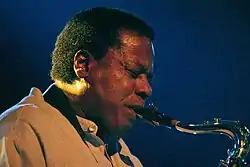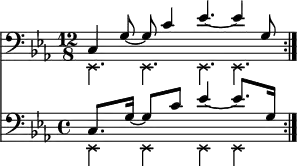Footprints (composition)
"Footprints" is a jazz standard composed by saxophonist Wayne Shorter and first recorded for his album Adam's Apple in 1966. The first commercial release of the song was a different recording on the Miles Davis album Miles Smiles recorded later in 1966, but released earlier. It has become a jazz standard.
Rhythm

Although often written in 3
4 or 6
8, it is not a jazz waltz because the feel alternates between simple meter and compound meter. On Miles Smiles, the band playfully explores the correlation between African-based 12
8 (or 6
8) and 4
4. Drummer Tony Williams freely moves from swing, to the three-over-two cross rhythm—and to its 4
4 correlative.[1]
The ground of four main beats is maintained throughout the piece. The bass switches to 4
4 at 2:20. Ron Carter’s 4
4 figure is known as tresillo in Afro-Cuban music and is the duple-pulse correlative of the 12
8 figure.[2] This may have been the first overt expression of systemic, African-based cross-rhythm used by a straight ahead jazz group. During Davis’s first trumpet solo, Williams shifts to a 4
4 jazz ride pattern while Carter continues the 12
8 bass line.
The following example shows the 12
8 and 4
4 forms of the bass line. The slashed noteheads indicate the main beats (not bass notes), where one ordinarily taps their foot to "keep time."
Harmony
Harmonically, "Footprints" takes the form of a 12-bar C minor blues, but this is masked not only by its triple time signature but by its avant garde turnaround. In the key of C minor, a normal turnaround would be Dm7(♭5), G7, Cm7. But Shorter doubles the harmonic rhythm of the turnaround, and the progression reads: F♯m7(♭5), F7(♯11), Eaug7(♯9), A7(♯9), Cm7. In jazz jam sessions and for educational purposes, players often choose D7(♯11) D♭7(♯11) Cm7 as turnaround, which also fits with the original melody.
References
- "Footprints" Miles Smiles (Miles Davis). Columbia CD (1967).
- Peñalosa, David (2010: 43). The Clave Matrix; Afro-Cuban Rhythm: Its Principles and African Origins. Redway, CA: Bembe Inc. ISBN 1-886502-80-3.
